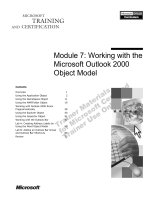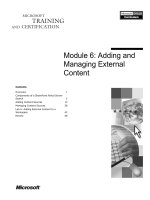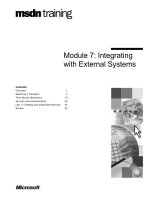Tài liệu Module 6: Working with Subqueries docx
Bạn đang xem bản rút gọn của tài liệu. Xem và tải ngay bản đầy đủ của tài liệu tại đây (863.73 KB, 34 trang )
Contents
Overview 1
Introduction to Subqueries 2
Using a Subquery as a Derived Table 4
Using a Subquery as an Expression 5
Using a Subquery to Correlate Data 6
Using the EXISTS and
NOT EXISTS Clauses 13
Recommended Practices 15
Lab A: Working with Subqueries 16
Review 27
Module 6: Working with
Subqueries
Information in this document is subject to change without notice. The names of companies,
products, people, characters, and/or data mentioned herein are fictitious and are in no way intended
to represent any real individual, company, product, or event, unless otherwise noted. Complying
with all applicable copyright laws is the responsibility of the user. No part of this document may
be reproduced or transmitted in any form or by any means, electronic or mechanical, for any
purpose, without the express written permission of Microsoft Corporation. If, however, your only
means of access is electronic, permission to print one copy is hereby granted.
Microsoft may have patents, patent applications, trademarks, copyrights, or other intellectual
property rights covering subject matter in this document. Except as expressly provided in any
written license agreement from Microsoft, the furnishing of this document does not give you any
license to these patents, trademarks, copyrights, or other intellectual property.
2000 Microsoft Corporation. All rights reserved.
Microsoft, BackOffice, MS-DOS, PowerPoint, Visual Studio, Windows, Windows Media, and
Windows NT are either registered trademarks or trademarks of Microsoft Corporation in the
U.S.A. and/or other countries.
The names of companies, products, people, characters, and/or data mentioned herein are fictitious
and are in no way intended to represent any real individual, company, product, or event, unless
otherwise noted.
Other product and company names mentioned herein may be the trademarks of their respective
owners.
Project Lead: Cheryl Hoople
Instructional Designer: Cheryl Hoople
Technical Lead: LeRoy Tuttle
Program Manager: LeRoy Tuttle
Graphic Artist: Kimberly Jackson (Independent Contractor)
Editing Manager: Lynette Skinner
Editor: Wendy Cleary
Editorial Contributor: Elizabeth Reese
Copy Editor: Bill Jones (S&T Consulting)
Production Manager: Miracle Davis
Production Coordinator: Jenny Boe
Production Tools Specialist: Julie Challenger
Production Support: Lori Walker (S&T Consulting)
Test Manager: Sid Benavente
Courseware Testing: Testing Testing 123
Classroom Automation: Lorrin Smith-Bates
Creative Director, Media/Sim Services: David Mahlmann
Web Development Lead: Lisa Pease
CD Build Specialist: Julie Challenger
Online Support: David Myka (S&T Consulting)
Localization Manager: Rick Terek
Operations Coordinator: John Williams
Manufacturing Support: Laura King; Kathy Hershey
Lead Product Manager, Release Management: Bo Galford
Lead Product Manager: Margo Crandall
Group Manager, Courseware Infrastructure: David Bramble
Group Product Manager, Content Development: Dean Murray
General Manager: Robert Stewart
Module 6: Working with Subqueries iii
Instructor Notes
This module presents advanced query techniques, which include nested and
correlated subqueries. It describes when and how to use a subquery and how to
use subqueries to break down and perform complex queries.
At the end of this module, you will be able to:
!
Describe when and how to use a subquery.
!
Use subqueries to break down and perform complex queries.
Materials and Preparation
Required Materials
To teach this course, you need the following materials:
!
Microsoft
®
PowerPoint
®
file 2017A_06.ppt.
!
The C:\Moc\Demo\Ex_06.sql example file, which contains all of the
example scripts from the module, unless otherwise noted in the module.
Preparation Tasks
To prepare for this module, you should:
!
Read all of the materials.
!
Complete the lab.
Presentation:
45 Minutes
Lab:
30 Minutes
iv Module 6: Working with Subqueries
Module Strategy
Use the following strategy to present this module:
!
Introduction to Subqueries
Define subqueries and present basic facts and guidelines related to using
them. Point out that subqueries may be less efficient than joins because
subqueries specify the order in which to retrieve data. Joins allow the query
optimizer in Microsoft SQL Server
™
2000 to retrieve data in the most
efficient way.
!
Using a Subquery as a Derived Table
Describe how a derived table is a special use of a subquery in a FROM
clause to which an alias or user-specified name refers. Explain when to use
it. Review the example.
!
Using a Subquery as an Expression
Describe when and how to use a subquery as an expression. Review the
example.
!
Using a Subquery to Correlate Data
Discuss how correlated queries are processed. Use the graphic to illustrate
how correlated subqueries are evaluated. Point out the difference between a
correlated subquery and a nested subquery. In a correlated subquery, the
inner query is evaluated repeatedly, once for each row of the outer query.
Describe how to use a subquery to correlated data by mimicking JOIN and
HAVING clauses. Review the examples.
!
Using a Subquery with EXISTS and NOT EXISTS
Present the EXISTS and NOT EXISTS keywords in the context of their use
with correlated subqueries. Review the example.
Module 6: Working with Subqueries v
Customization Information
This section identifies the lab setup requirements for a module and the
configuration changes that occur on student computers during the labs. This
information is provided to assist you in replicating or customizing
Microsoft Official Curriculum (MOC) courseware.
The lab in this module is dependent on the classroom configuration
that is specified in the Customization Information section at the end of the
Classroom Setup Guide for course 2071A, Querying Microsoft SQL Server
2000 with Transact-SQL.
Lab Setup
There are no lab setup requirements that affect replication or customization.
Lab Results
There are no configuration changes on student computers that affect replication
or customization.
Importan
t
Module 6: Working with Subqueries 1
Overview
!
Introduction to Subqueries
!
Using a Subquery as a Derived Table
!
Using a Subquery as an Expression
!
Using a Subquery to Correlate Data
!
Using the EXISTS and NOT EXISTS Clauses
This module presents advanced query techniques, which include nested and
correlated subqueries, and how they can be used to modify data. It describes
when and how to use a subquery and how to use subqueries to break down and
perform complex queries.
At the end of this module, you will be able to:
!
Describe when and how to use a subquery.
!
Use subqueries to break down and perform complex queries.
Slide Objective
To provide a brief overview
of the topics covered in
this module.
Lead-in
In this module, you will learn
about advanced query
techniques.
2 Module 6: Working with Subqueries
Introduction to Subqueries
!
Why to Use Subqueries
#
To break down a complex query into a series of
logical steps
#
To answer a query that relies on the results of an
other query
!
Why to Use Joins Rather Than Subqueries
#
SQL Server executes joins faster than subqueries
!
How to Use Subqueries
A subquery is a SELECT statement nested inside a SELECT, INSERT,
UPDATE, or DELETE statement or inside another subquery. Often you can
rewrite subqueries as joins and use subqueries in place of an expression.
An expression is a combination of identifiers, values, and operators that
SQL Server evaluates to obtain a result.
Why to Use Subqueries
You use subqueries to break down a complex query into a series of logical steps
and, as a result, to solve a problem with a single statement. Subqueries are
useful when your query relies on the results of another query.
Why to Use Joins Rather Than Subqueries
Often, a query that contains subqueries can be written as a join. Query
performance may be similar with a join and a subquery. The query optimizer
usually optimizes subqueries so that it uses the sample execution plan that a
semantically equivalent join would use. The difference is that a subquery may
require the query optimizer to perform additional steps, such as sorting, which
may influence the processing strategy.
Using joins typically allows the query optimizer to retrieve data in the most
efficient way. If a query does not require multiple steps, it may not be necessary
to use a subquery.
Slide Objective
To discuss whether to
use subqueries.
Lead-in
Subqueries are a series of
SELECT statements. Often,
you can rewrite subqueries
as joins.
Module 6: Working with Subqueries 3
How to Use Subqueries
When you decide to use subqueries, consider the following facts and guidelines:
!
You must enclose subqueries in parentheses.
!
You can use a subquery in place of an expression as long as a single value
or list of values is returned. You can use a subquery that returns a multi-
column record set in place of a table or to perform the same function as a
join.
!
You cannot use subqueries that retrieve columns that contain text and
image data types.
!
You can have subqueries within subqueries, nesting up to 32 levels. The
limit varies based on available memory and the complexity of other
expressions in the query. Individual queries may not support nesting up to
32 levels.
Delivery Tip
Review each fact and
guideline to consider when
using subqueries.
4 Module 6: Working with Subqueries
Using a Subquery as a Derived Table
!
Is a Recordset Within a Query That Functions as a Table
!
Takes the Place of a Table in the FROM Clause
!
Is Optimized with the Rest of the Query
USE northwind
SELECT T.orderid, T.customerid
FROM ( SELECT orderid, customerid
FROM orders ) AS T
GO
USE northwind
SELECT T.orderid, T.customerid
FROM ( SELECT orderid, customerid
FROM orders ) AS T
GO
You create a derived table by using a subquery in place of a table in a FROM
clause. A derived table is a special use of a subquery in a FROM clause to
which an alias or user-specified name refers. The result set of the subquery in
the FROM clause forms a table that the outer SELECT statement uses.
This example uses a subquery to create a derived table in the inner part of the
query that the outer part queries. The derived table itself is functionally
equivalent to the whole query, but it is separated for illustrative purposes.
USE northwind
SELECT T.orderid, T.customerid
FROM ( SELECT orderid, customerid
FROM orders ) AS T
GO
When used as a derived table, consider that a subquery:
!
Is a recordset within a query that functions as a table.
!
Takes the place of a table in the FROM clause.
!
Is optimized with the rest of the query.
Slide Objective
To describe how to use a
subquery as a derived table.
Lead-in
You create a derived table
by using a subquery in place
of a table in a FROM clause.
Example
Module 6: Working with Subqueries 5
Using a Subquery as an Expression
!
Is Evaluated and Treated as an Expression
!
Is Executed Once for the Query
USE pubs
SELECT title, price
,( SELECT AVG(price) FROM titles) AS average
,price-(SELECT AVG(price) FROM titles) AS difference
FROM titles
WHERE type='popular_comp'
GO
USE pubs
SELECT title, price
,( SELECT AVG(price) FROM titles) AS average
,price-(SELECT AVG(price) FROM titles) AS difference
FROM titles
WHERE type='popular_comp'
GO
In Transact-SQL, you can substitute a subquery wherever you use an
expression. The subquery must evaluate to a scalar value, or to a single column
list of values. Subqueries that return a list of values replace an expression in a
WHERE clause that contains the IN keyword.
When used as an expression, consider that a subquery:
!
Is evaluated and treated as an expression. The query optimizer often
evaluates an expression as equivalent to a join connecting to a table that has
one row.
!
Is executed once for the entire statement.
This example returns the price of a popular computer book, the average price of
all books, and the difference between the price of the book and the average
price of all books.
USE pubs
SELECT title, price
,(SELECT AVG(price) FROM titles) AS average
,price-(SELECT AVG(price) FROM titles) AS difference
FROM titles
WHERE type='popular_comp'
GO
Slide Objective
To describe how to use a
subquery as an expression.
Lead-in
You can substitute a
subquery wherever you use
an expression in SELECT,
UPDATE, INSERT, and
DELETE statements.
Delivery Tip
Point out that subqueries
that return a list of values
replace an expression in a
WHERE clause that
contains the IN keyword.
Example
6 Module 6: Working with Subqueries
$
$$
$ Using a Subquery to Correlate Data
!
Evaluating a Correlated Subquery
!
Mimicking a JOIN Clause
!
Mimicking a HAVING Clause
You can use a correlated subquery as a dynamic expression that changes for
each row of an outer query.
The query processor performs the subquery for each row in the outer query, one
row at a time, which is in turn evaluated as an expression for that row and
passed to the outer query. The correlated subquery is effectively a JOIN
between the dynamically executed subquery and the row from the outer query.
You can typically rewrite a query in a number of ways and still obtain the same
results. Correlated subqueries break down complex queries into two or more
simple, related queries.
You can easily recognize correlated subqueries. A column from a table
inside the subquery is compared to a column from a table outside the subquery.
Slide Objective
To describe how to use a
subquery to correlate data.
Lead-in
A correlated subquery can
be used as a dynamic
expression that changes for
each row of an outer query.
Tip
Module 6: Working with Subqueries 7
Evaluating a Correlated Subquery
Back to Step 1
Back to Step 1
USE northwind
SELECT orderid, customerid
FROM orders AS or1
WHERE 20 < (SELECT quantity
FROM [order details] AS od
WHERE or1.orderid = od.orderid
AND od.productid = 23)
GO
USE northwind
SELECT orderid, customerid
FROM orders AS or1
WHERE 20 < (SELECT quantity
FROM [order details] AS od
WHERE or1.orderid = od.orderid
AND od.productid = 23)
GO
Outer query passes column
values to the inner query
Outer query passes column
Outer query passes column
values to the inner query
values to the inner query
Inner query uses that value to
satisfy the inner query
Inner query uses that value to
Inner query uses that value to
satisfy the inner query
satisfy the inner query
Inner query returns a value
back to the outer query
Inner query returns a value
Inner query returns a value
back to the outer query
back to the outer query
The process is repeated for the
next row of the outer query
The process is repeated for the
The process is repeated for the
next row of the outer query
next row of the outer query
Example 1
Example 1
When you create a correlated subquery, the inner subqueries are evaluated
repeatedly, once for each row of the outer query:
!
SQL Server executes the inner query for each row that the outer
query selects.
!
SQL Server compares the results of the subquery to the results outside the
subquery.
This example returns a list of customers who ordered more than 20 pieces of
product number 23.
USE northwind
SELECT orderid, customerid
FROM orders AS or1
WHERE 20 < (SELECT quantity
FROM [order details] AS od
WHERE or1.orderid = od.orderid
AND od.productid = 23)
GO
orderid customerid
10337 FRANK
10348 WANDK
10396 FRANK
10402 ERNSH
10462 CONSH
.
.
.
(11 row(s) affected)
Slide Objective
To discuss how correlated
subqueries are processed.
Lead-in
When you create a
correlated subquery, the
inner subqueries are
evaluated repeatedly,
once for each row of the
outer query.
Delivery Tip
Compare correlated
subqueries to
nested subqueries.
Example 1
Result









